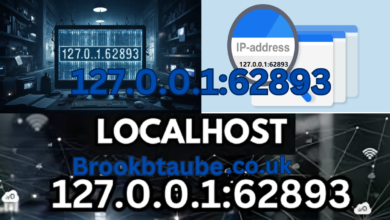Understanding 127.0.0.1:49342 The Cornerstone of Local Networking

In the vast universe of networking, some concepts serve as fundamental building blocks, essential for both novices and experts alike. One such cornerstone is the IP address 127.0.0.1:49342, often accompanied by various port numbers such as 49342. This seemingly cryptic combination plays a critical role in local networking and development environments. This article aims to unravel the significance of 127.0.0.1:49342, exploring its components, functions, and practical applications in the realm of computer networking.
The Basics of IP Addresses and Ports
Understanding IP Addresses
An IP (Internet Protocol) address is a unique identifier assigned to each device connected to a network. It serves two primary functions: identifying the host or network interface and providing the location of the host in the network. IP addresses come in two versions: IPv4 and IPv6. IPv4 addresses are composed of four octets separated by periods (e.g., 192.168.0.1), whereas IPv6 addresses are longer and more complex (e.g., 2001:0db8:85a3:0000:0000:8a2e:0370:7334).
The Significance of 127.0.0.1
Within the IPv4 space, certain addresses are reserved for specific purposes. The address 127.0.0.1:49342.1 is a special-purpose address known as the loopback address. It is used by a device to send network traffic to itself. This capability is crucial for testing and development because it allows developers to run network services locally without requiring an active internet connection.
Understanding Ports
While an IP address identifies a device on a network, ports identify specific services or applications running on that device. Ports range from 0 to 65535, with the first 1024 ports (known as well-known ports) reserved for standard services like HTTP (port 80) and HTTPS (port 443). Ports above 1024, known as dynamic or private ports, are typically used for custom or ephemeral purposes, including development and testing.
The Role of 127.0.0.1:49342 in Networking
Loopback Address: A Detailed Look
The loopback address 127.0.0.1:49342 is a critical component of TCP/IP networks. When a device uses this address, it communicates with itself through the network stack. This self-referential communication is invaluable for testing software, debugging network configurations, and ensuring that networking components behave correctly before deployment.
The loopback interface is a virtual network interface, meaning it doesn’t correspond to any physical network hardware. Instead, it’s a software construct that mimics the behavior of a network interface, allowing applications to interact with it just like they would with a real network interface.
Practical Applications
- Software Testing and Development: Developers often use 127.0.0.1 to run local servers for testing web applications, APIs, and other networked software. This setup allows them to develop and troubleshoot software in an isolated environment before making it publicly accessible.
- Network Configuration and Diagnostics: Network administrators use loopback addresses to test the network stack on a local machine. Commands like
ping 127.0.0.1can help diagnose network interface issues, ensuring that the TCP/IP stack is functioning correctly. - Security: By binding services to 127.0.0.1, administrators can restrict access to those services, ensuring they are only accessible from the local machine. This technique is often employed to secure databases, development servers, and other sensitive services during development.
The Importance of Ports in Local Networking
Port 49342: An Example
Port 49342 falls within the dynamic range, meaning it is not reserved for any specific service. This flexibility makes it ideal for temporary, ad-hoc applications, such as testing new software or running development servers. When a service binds to port 49342 on the loopback address, it is accessible only from the local machine, ensuring a controlled and isolated testing environment.
Dynamic Port Allocation
Dynamic or ephemeral ports, like 49342, are typically assigned by the operating system when an application requests a port for temporary use. These ports are ideal for applications that do not need a fixed port number, such as client-side software connecting to a remote server or local testing environments where the exact port number is less critical.
Combining 127.0.0.1 and Port 49342
Local Development Environments
When developing networked applications, it’s common to run servers locally on the loopback address with a dynamically allocated port. For instance, a web developer might start a local web server on 127.0.0.1:49342 to test a new website. This setup ensures that the server is only accessible from the local machine, protecting it from external access and interference.
Security Implications
Binding services to 127.0.0.1:49342 enhances security by limiting access to the local machine. This isolation is particularly important during development, where services might be unstable or contain sensitive debugging information. By restricting access, developers can safely test and debug their applications without exposing them to potential threats from the broader network or internet.
Practical Examples
Example 1: Running a Local Web Server
Consider a scenario where a developer is working on a web application. They need to test the application locally before deploying it to a production server. By running a local web server on 127.0.0.1:49342, the developer can access the application through a web browser by navigating to 127.0.0.1:49342. This setup allows them to interact with the application in a controlled environment, ensuring that all components function correctly.
import http.server
import socketserver
PORT = 49342
Handler = http.server.SimpleHTTPRequestHandler
with socketserver.TCPServer(("127.0.0.1", PORT), Handler) as httpd:
print("Serving at port", PORT)
httpd.serve_forever()The above Python code snippet sets up a simple HTTP server on 127.0.0.1:49342, allowing the developer to serve and test web content locally.
Example 2: Testing a REST API
In another scenario, a developer is creating a REST API. They can run the API server locally on 127.0.0.1:49342 and use tools like Postman or curl to send requests and receive responses. This local setup facilitates rapid development and debugging.
const express = require('express');
const app = express();
const port = 49342;
app.get('/', (req, res) => {
res.send('Hello, World!');
});
app.listen(port, '127.0.0.1', () => {
console.log(`API server listening at http://127.0.0.1:${port}`);
});This JavaScript code, using the Express framework, creates a simple API server that listens on 127.0.0.1:49342. The developer can then test the API locally without exposing it to the internet.
Challenges and Considerations
Port Conflicts
One challenge when using dynamic ports is the potential for port conflicts. If multiple services attempt to use the same port, a conflict occurs, preventing one or more services from starting. Developers can mitigate this risk by ensuring that ports are dynamically allocated and by checking for availability before binding a service to a port.
Performance and Resource Usage
Running multiple services locally can consume significant system resources, potentially impacting performance. Developers should monitor resource usage and optimize services to minimize their footprint. Virtualization and containerization technologies, such as Docker, can help manage and isolate resources effectively.
Security Risks
While binding services to 127.0.0.1 enhances security by restricting access, it is not foolproof. Malicious software on the local machine could potentially exploit local services. Developers should implement robust security measures, such as input validation, authentication, and encryption, even for services running on the loopback address.
Advanced Topics
Loopback Interfaces in IPv6
IPv6 also supports loopback addressing with the address ::1. Similar to 127.0.0.1 in IPv4, ::1 allows devices to communicate with themselves over the IPv6 protocol. Developers working with IPv6 networks should be familiar with this address and its applications.
Containerization and Local Networking
Containerization platforms like Docker provide isolated environments for running services. Docker uses network namespaces to create virtual network interfaces, enabling containers to use addresses like 127.0.0.1:49342 for local communication. This isolation simplifies development and testing by ensuring that services do not interfere with each other or with the host system.
version: '3'
services:
web:
image: my-web-app
ports:
- "49342:80"The above Docker Compose file demonstrates how to map port 49342 on the host to port 80 in a container, allowing local access to a web service running inside the container.
Conclusion
The combination of the IP address 127.0.0.1:49342 and dynamic ports like 49342 is a fundamental aspect of local networking, crucial for development, testing, and diagnostics. By understanding how to leverage this combination, developers and network administrators can create secure, isolated environments that facilitate efficient and effective software development.
Whether you are running a local web server, testing an API, or configuring network services, the principles discussed in this article provide a solid foundation for utilizing 127.0.0.1:49342 effectively. As networking technologies continue to evolve, the importance of these basic concepts remains undiminished, underscoring their enduring relevance in the digital age.



